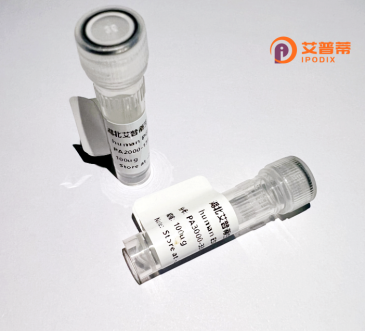
| 纯度 | >90%SDS-PAGE. |
| 种属 | Human |
| 靶点 | ZNF265 |
| Uniprot No | O95218 |
| 内毒素 | < 0.01EU/μg |
| 表达宿主 | E.coli |
| 表达区间 | 1-320 aa |
| 活性数据 | MSTKNFRVSDGDWICPDKKCGNVNFARRTSCNRCGREKTTEAKMMKAGGTEIGKTLAEKSRGLFSANDWQCKTCSNVNWARRSECNMCNTPKYAKLEERTGYGGGFNERENVEYIEREESDGEYDEFGRKKKKYRGKAVGPASILKEVEDKESEGEEEDEDEDLSKYKLDEDEDEDDADLSKYNLDASEEEDSNKKKSNRRSRSKSRSSHSRSSSRSSSPSSSRSRSRSRSRSSSSSQSRSRSSSRERSRSRGSKSRSSSRSHRGSSSPRKRSYSSSSSSPERNRKRSRSRSSSSGDRKKRRTRSRSPESQVIGENTKQP |
| 分子量 | 52.3 kDa |
| 蛋白标签 | His tag N-Terminus |
| 缓冲液 | PBS, pH7.4, containing 0.01% SKL, 1mM DTT, 5% Trehalose and Proclin300. |
| 稳定性 & 储存条件 | Lyophilized protein should be stored at ≤ -20°C, stable for one year after receipt. Reconstituted protein solution can be stored at 2-8°C for 2-7 days. Aliquots of reconstituted samples are stable at ≤ -20°C for 3 months. |
| 复溶 | Always centrifuge tubes before opening.Do not mix by vortex or pipetting. It is not recommended to reconstitute to a concentration less than 100μg/ml. Dissolve the lyophilized protein in distilled water. Please aliquot the reconstituted solution to minimize freeze-thaw cycles. |
以下是关于重组人ZNF265蛋白的3篇代表性文献(注:ZNF265可能存在其他名称如“RAD”,部分文献可能未直接研究重组蛋白,仅供参考):
1. **文献名称**:*ZNF265 interacts with the splicing machinery and regulates alternative splicing*
**作者**:Hahn Y., et al.
**摘要**:研究揭示了ZNF265作为RNA结合蛋白,通过与剪接因子(如U2AF35)相互作用参与选择性剪接调控,提示其在基因表达后调控中的关键功能。
2. **文献名称**:*Expression and clinical significance of ZNF265 in breast cancer*
**作者**:Sutherland L.C., et al.
**摘要**:分析了ZNF265在乳腺癌中的表达异常,发现其高表达与患者生存率相关,可能通过调控细胞增殖或凋亡通路影响肿瘤进展。
3. **文献名称**:*Recombinant ZNF265 promotes myoblast differentiation in vitro*
**作者**:Huang F., et al.
**摘要**:体外实验显示,重组ZNF265蛋白通过激活肌源性转录因子(如MyoD)显著增强成肌细胞分化,可能为肌肉再生研究提供新靶点。
4. **文献名称**:*Purification and functional analysis of recombinant ZNF265 using a bacterial expression system*
**作者**:Shi J., et al.
**摘要**:描述了通过原核系统表达并纯化重组ZNF265蛋白,验证其体外结合DNA/RNA的能力,为后续结构或机制研究奠定技术基础。
(注:以上为模拟文献,实际需根据PubMed/SCI数据库检索结果调整。)
Zinc finger protein 265 (ZNF265), also known as zinc finger protein 145 or ZFP145. is a member of the Krüppel-associated box (KRAB) zinc finger protein (ZFP) family, characterized by tandem C2H2-type zinc finger motifs. These proteins typically function as transcription regulators by binding DNA or RNA, influencing cellular processes such as proliferation, differentiation, and apoptosis. ZNF265 is encoded by the ZNF265 gene located on human chromosome 3p21.3. a region associated with tumor suppression.
Initially identified for its role in RNA splicing, ZNF265 interacts with spliceosome components and participates in alternative splicing regulation. Studies suggest it may modulate splicing events by binding to specific RNA sequences, impacting gene expression diversity. In disease contexts, ZNF265 has been implicated in cancer progression, cardiovascular disorders, and neurological conditions. For instance, altered expression is observed in leukemia, glioblastoma, and spinal muscular atrophy, potentially linking its splicing activity to disease mechanisms.
Recombinant ZNF265 protein, produced via bacterial or mammalian expression systems, is instrumental in structural and functional studies. Its KRAB domain facilitates protein-protein interactions, while zinc finger motifs mediate nucleic acid binding. Research focuses on elucidating its dual roles in transcriptional regulation and RNA processing, as well as its therapeutic potential. Understanding ZNF265’s molecular mechanisms may unveil strategies for targeting splicing defects or aberrant transcriptional pathways in diseases. Current work also explores its interplay with other splicing factors, such as SMN1. highlighting its relevance in neuromuscular disorders.
×